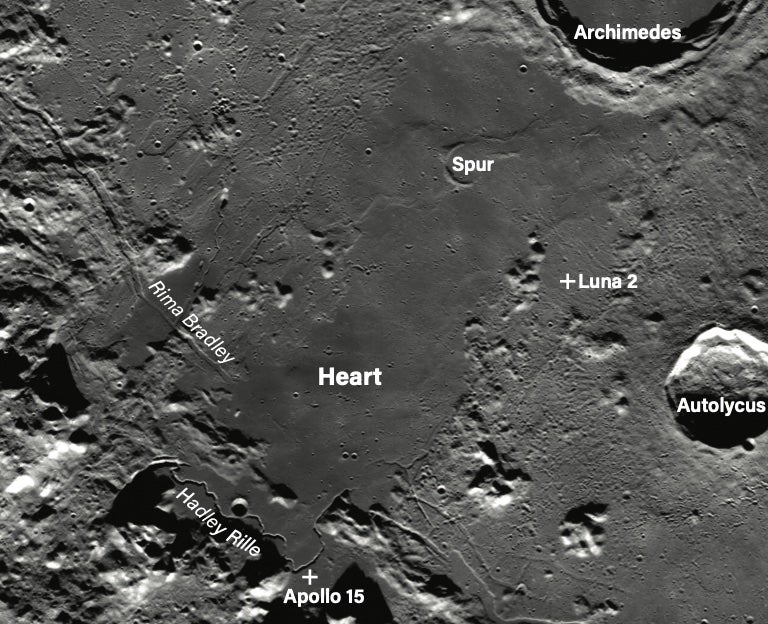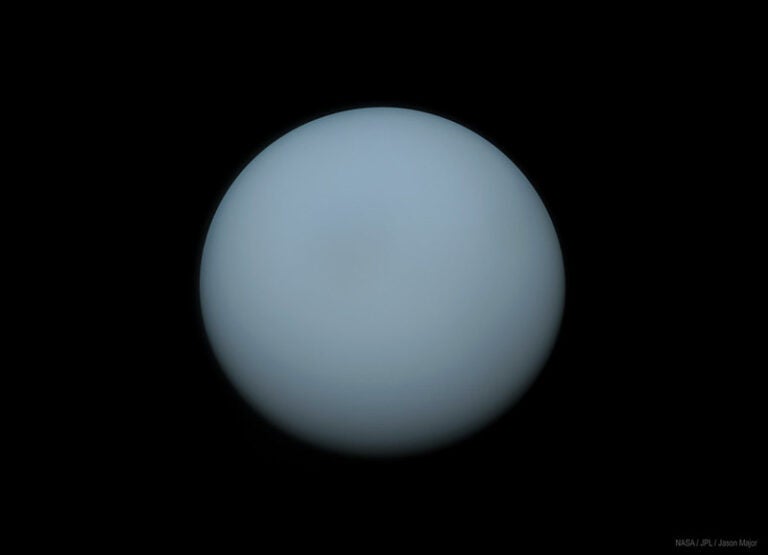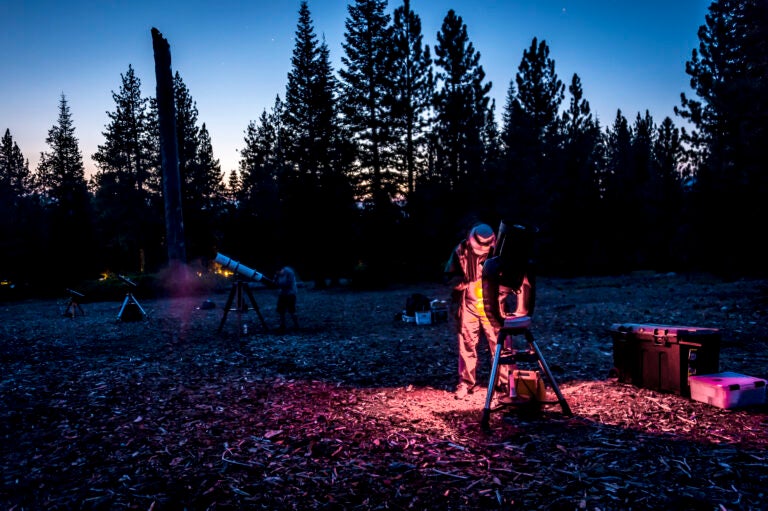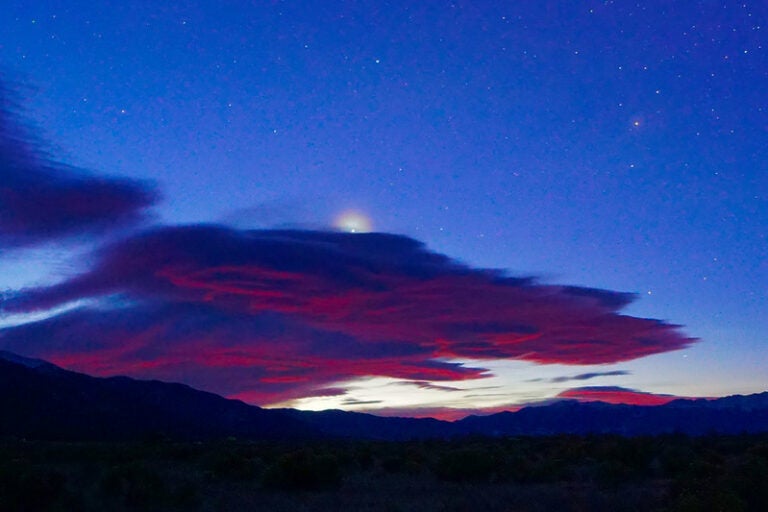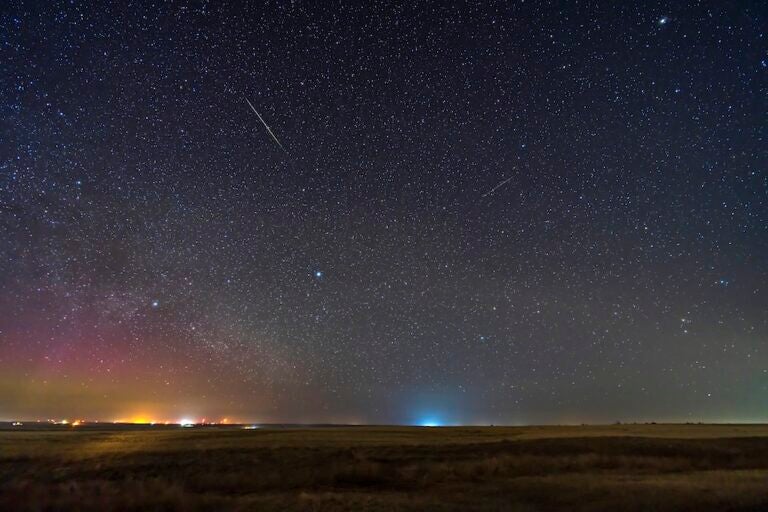
Summer in the Northern Hemisphere is a frustrating time for many amateur astronomers. The nights never get dark enough to easily see the faint, fuzzy galaxies and nebulae they enjoy looking at through their telescopes, and there are fewer bright stars in the sky too. Occasionally a display of electric-blue noctilucent clouds will decorate the northern sky, but only a dedicated band of observers stay up late to watch and photograph these.
So, many northern skywatchers go into a kind of reverse hibernation in summer and catch up on missed sleep until autumn’s darker skies roll around.
But hang on… isn’t summer “Milky Way season?” Don’t all the books and magazines say that?
They do, but what they do not say is that in early- and mid-summer it’s actually quite hard to see the Milky Way from even a dark-sky location; the sky is so bright that its faint star clouds and darker dust lanes are washed out. But by the start of August the Milky Way is a magical sight from anywhere away from streetlights and light pollution — a wide, misty vapor trail that cuts the sky in half.
The problem becomes that there is so much to see along the Milky Way that beginner observers don’t know where to start. If only there was a guide pointing out the most interesting and beautiful features, just as there are guides to help tourists on long road trips across the U.S.…
Well, here it is! We’re going to take you on an astronomical road trip along the length of the Milky Way, stopping at a the most fascinating places along the way to stretch our legs and enjoy the view!
Heading out
You’ll have to wait until the sky is quite dark to begin our Milky Way Summer Road Trip, which means staying up or getting up at round 1 am. Then, facing the northeast, you’ll see a thumbnail-sized knot of stars low in the sky. This is M45, the famous Pleiades star cluster. Known as the Seven Sisters because people with good eyesight can see the seven brightest of its hundreds of members, this star cluster is one of the closest to Earth, just 445 light-years away. It’s a beautiful sight in binoculars and through telescopes at low power.
Next, move left from the Pleiades to the bright, gold-hued star Capella. With a magnitude of 0.1, Capella is the 6th brightest str in the sky and the closest 1st-magnitude star to the Northern Celestial Pole. About 42 light-years from Earth, it is a binary system. If you have binoculars, sweep them slowly around the sky just beneath Capella and you’ll find many small, pretty star clusters.
From Capella, drift your gaze a short distance to the upper right, where you’ll find what looks like an upside-down letter Y of stars, or maybe even a pair of gardening shears. This is the constellation Perseus, which represents one of the most famous heroes in Greek mythology. Again, if you sweep your binoculars across Perseus, you’ll see many beautiful blue and white stars.
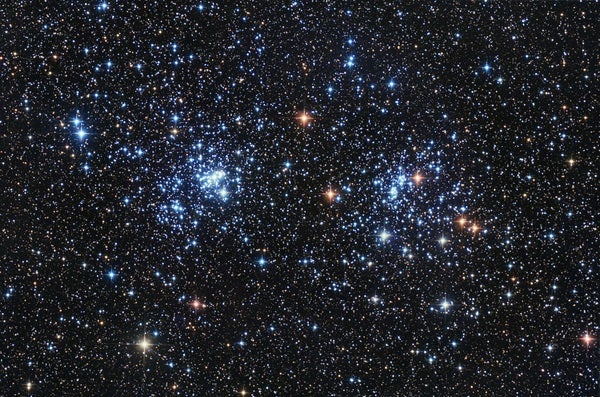
Look just above the Y-shape of Perseus, perhaps a couple of fingers’ width, and you’ll see out of the corner of your eye a misty, smudgy patch. Binoculars revealed a pir of star clusters so close together they almost appear to touch. Known together — unsurprisingly — as the Double Cluster, NGC 869 and NGC 884 mark the sword Perseus used to cut the head off the serpent-haired Medusa. They were first cataloged by the Greek astronomer Hipparchus in 130 B.C.E. but puzzlingly, Charles Messier didn’t include it in his famous catalog, even though he included many smaller, fainter clusters. Like the Pleiades, the 7,500-light-years-distant Double Cluster is best seen at low magnification.
Leaving the Double Cluster behind, tilt your head back a little until you come to a striking zigzag of stars that looks like a letter W standing on its side. This is the constellation Cassiopeia, representing an exceedingly vain Ethiopian queen who was flung into the sky by gods after claiming — very unwisely — that she was more beautiful than them. As a circumpolar constellation that circles the North Star, she now spends half the year upside-down, clutching at her throne trying desperately not to plummet back down to Earth.
The Summer Triangle

Having seen Cassiopeia, tilt your head right back until you’re staring straight above you. There you’ll see a very bright white star. This is Deneb, the brightest star in the constellation Cygnus the Swan. With a magnitude of 1.3, Deneb — whose name means “tail” — is the 19th brightest star in the sky. It is a true beast of a star: a white supergiant, some 50,000 to 100,000 times more luminous than our own Sun and more than 100 times wider too. If it replaced our Sun in the center of our solar system it would swallow up Mercury and Venus, and possibly even Earth and Mars…
If you look closely, you’ll see that Deneb lies at the top of a very striking cross of stars that looks like a crucifix or perhaps a dagger. This is the Northern Cross asterism, and it’s much bigger than its Southern Hemisphere counterpart, the famous Southern Cross.
Next, still looking up at Deneb, turn around 180° on the spot, letting the stars wheel round your head until you’re facing southwest and all the sights you’ve seen so far are behind you. A short distance to the lower right of Deneb, down at its four o’clock position, you’ll see an even brighter, blue-white star. This is beautiful Vega, the 5th brightest star in the sky. With a magnitude of 0.0, Vega is also known as the Harp Star because it is the brightest star in Lyra the Lyre. Only 25 light-years away, it is one of the closest stars to us. Vega is a class A0 star that rotates so rapidly — once every 12.5hrs — that it bulges at its equator. If it spun any faster, it would probably rip itself apart. If you’re a fan of the sci-fi film Contact, you’ll know Vega is the star Ellie Arroway (Jodie Foster) traveled to in her alien-designed spaceship.
A short distance from Vega lies M57, the famous Ring Nebula. This is a planetary nebula, so called because it looks like a tiny planet’s disk through a telescope under low magnification. At high magnification it looks like a smoky ring with a darker center.
Look to the lower left of Vega, around seven o’clock, and you’ll come to another bright white star. This is Altair, the third star in a large asterism known as the Summer Triangle. At magnitude 0.8, it is the 12th brightest star in the sky, and at 16.8 light-years away, another of the closest stars to our Sun.
If your sky is properly dark without any light pollution (or moonlight), you’ll see that the Summer Triangle frames a long, misty, vertical smudge that looks like a patch of mist. This is the Cygnus Star Cloud, a dense concentration of hundreds of thousands of faraway stars. Look at it through binoculars or the lowest power telescope eyepiece you have, and you’ll see stars as thick as pollen grains.
Toward the bottom of this dense star cloud is a blue star much fainter than any of the stars in the Summer Triangle but just as important. Marking the bottom of the Northern Cross, 3rd-magnitude, 380-light-years distant Albireo is one of the most famous double stars in the sky. Look at it through a telescope and you’ll see it split into a beautiful blue star and a lovely golden-hued star shining very close together, looking like a sapphire next to a droplet of molten gold. Having stretched your legs walking down the Cygnus Star Cloud and past Albireo, continue down the Milky Way, lowering your gaze until you’re looking perhaps a third of the way up from the skyline to the zenith. Now you’ll notice another misty area, much smaller than the Cygnus Star Cloud. This is the Scutum Star Cloud and, if you look at it through binoculars or a low-power telescope eyepiece, you’ll see it is an area where faint stars are packed so closely together that they look like a yellow-white smoky smudge. In the top left corner of the cloud is a beautiful star cluster: M11, the Wild Duck Cluster, which early telescopic observers thought looked like a flock of ducks in flight.
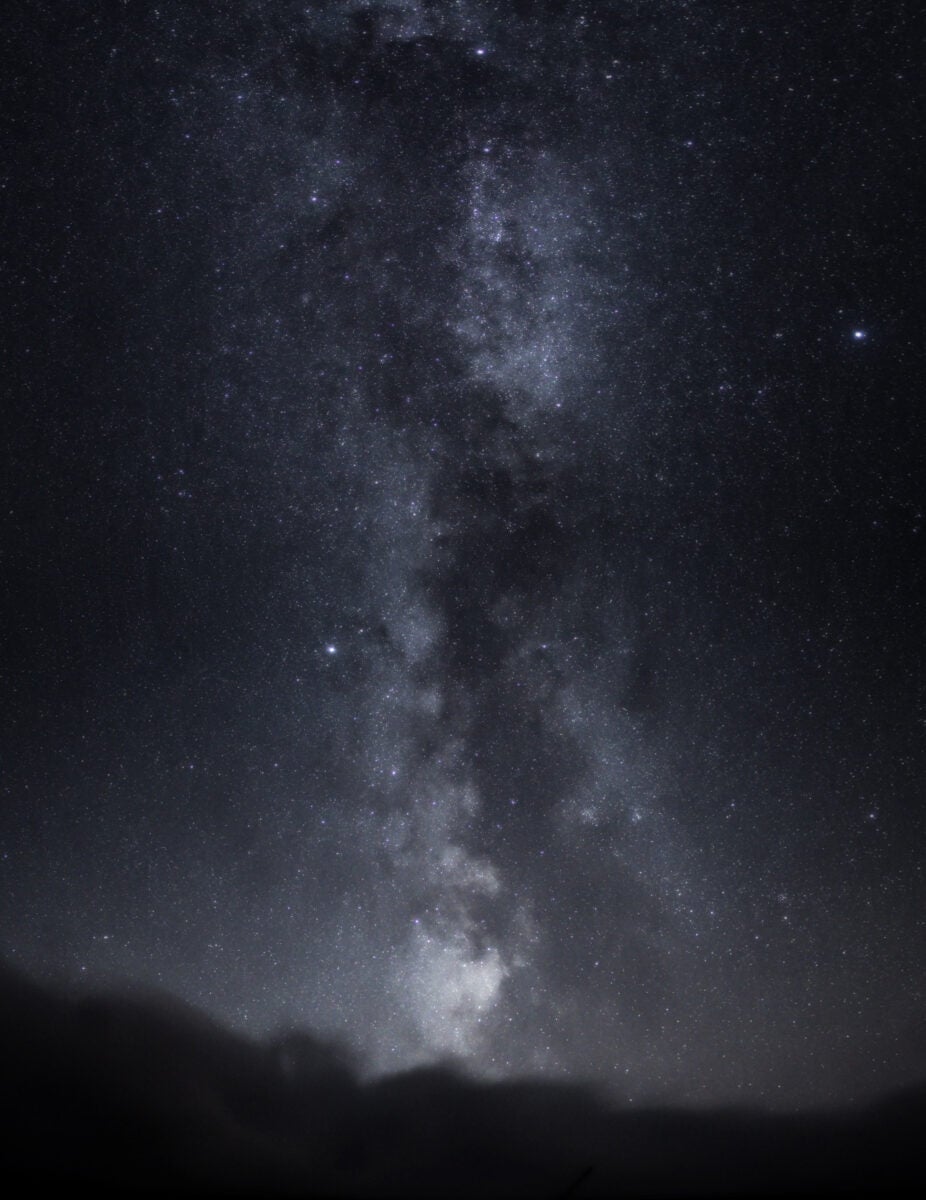
Winding down
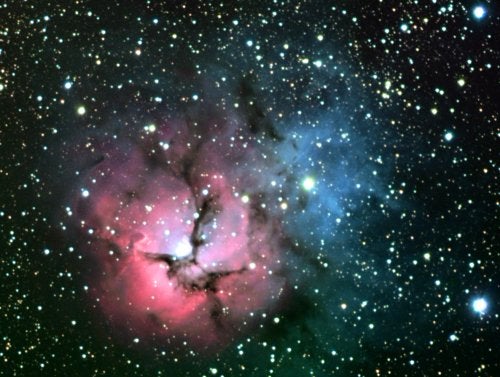
We’re running out of highway, and our summer Milky Way road trip is almost complete. Look lower down the frothy trail of the Milky Way and you’ll see it starts to thicken and bulge out as you approach the horizon, like the smoke rising from a distant campfire. You’re now looking toward the constellation Sagittarius, through about 28,000 light-years toward the center of our Milky Way Galaxy and the Sagittarius Star Clouds. Here the stars are so densely packed that they really do look like thin clouds moving up from beyond the horizon to cover the starry sky. But sweep your binoculars or telescope across these clouds and you’ll see stars as thick as dust, with many fascinating deep-sky objects embedded within, including M20, or the Trifid Nebula. This is one of the most famous Messier objects in the sky. It’s actually three nebule in one: a red-hued star-forming region, a blue reflection nebula, and a dark nebula. They lie around 5,000 light-years from us. M20 is just visible to the naked eye as a small misty patch, but looks much more impressive when viewed through a telescope and most impressive of all on long-exposure photographs.
Just beneath the Trifid Nebula is M8, the Lagoon Nebula. This 4,000-light-years-distant stellar nursery is considered by many observers to be one of the most beautiful nebule and would definitely be as popular as the Orion Nebula (M42) if it was higher in the sky and undimmed by its proximity to the Milky Way’s frothy center. It can be seen with the naked eye under good conditions, but a telescope gives beautiful views of the many wispy billows of gas and knots and strands of darker dusty material within it.
The final stop on our road trip is a strikingly orange-red star, shining just above the southwestern horizon. This is mighty Antares, brightest star in the constellation Scorpius the Scorpion. Flickering and fluttering in the summer sky like the flames of a distant campfire, at magnitude 1, the 550-light-years-distant Antares is the 15th brightest star in the sky. Like the winter star Betelgeuse, ruddy Antares is a red supergiant that dwarfs our own Sun and would consume all the worlds out to Mars if dropped into the Sun’s place in our solar system.
And so ends our summer Milky Way road trip. But there’s lots more to see. You’ll just have to head out again another time, with a good star map or your favorite planetarium app, and take your own leisurely drive down summer’s heavenly highway.




